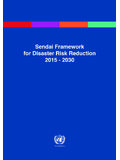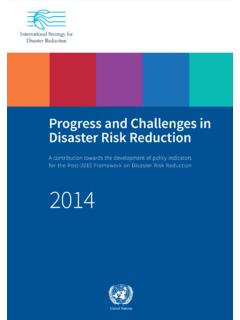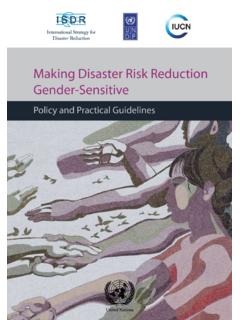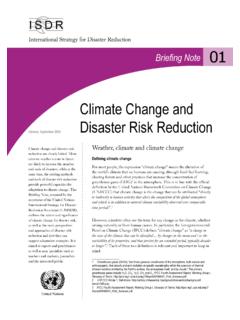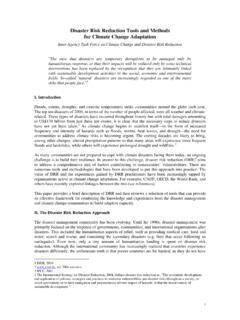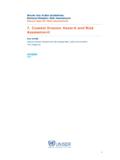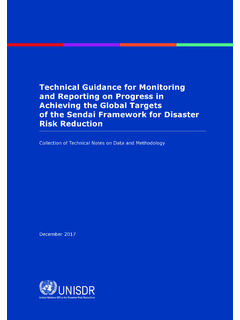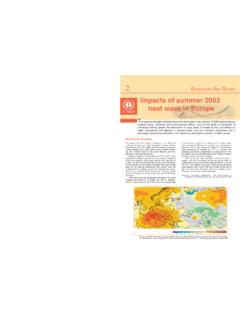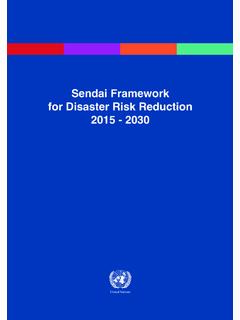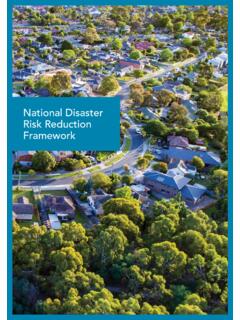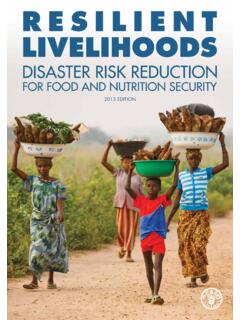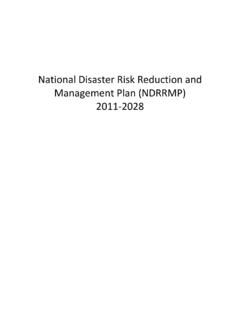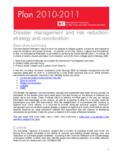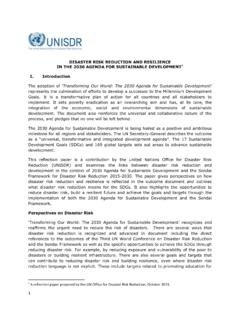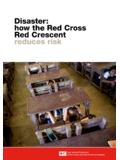Transcription of Making Cities Resilient – My City is Getting Ready! …
1 24 Making Cities Resilient My city is Getting ready ! CHAPTER 2 What are the Ten Essentials for Making Cities disaster Resilient ?Port-au-Prince, Haiti, 2010: It is not the earthquakes that kill people, but the buildings collapsing on them. CHAPTER 2 What are the Ten Essentials for Making Cities disaster Resilient ? 25 This chapter offers a brief overview of the Ten Essentials, including the critical and interdependent steps local governments may take to make their city more disaster Resilient . It provides the rationale for each Essential, pointing out strategic areas of intervention and identifying key actions. The actions identified under each Essential should be part of the overall disaster risk reduction planning process and influence urban development planning and design.
2 The Ten Essentials for Making Cities Resilient Checklist1. Put in place organisation and coordination to understand and reduce disaster risk, based on participation of citizen groups and civil society. Build local alliances. Ensure that all departments understand their role in disaster risk reduction and Assign a budget for disaster risk reduction and provide incentives for homeowners, low income families, communities, businesses and the public sector to invest in reducing the risks they Maintain up to date data on hazards and vulnerabilities. Prepare risk assessments and use these as the basis for urban development plans and decisions, ensure that this information and the plans for your city s resilience are readily available to the public and fully discussed with Invest in and maintain critical infrastructure that reduces risk, such as flood drainage, adjusted where needed to cope with climate Assess the safety of all schools and health facilities and upgrade these as Apply and enforce realistic, risk compliant building regulations and land use planning principles.
3 Identify safe land for low income citizens and upgrade informal settlements, wherever Ensure that education programmes and training on disaster risk reduction are in place in schools and local Protect ecosystems and natural buffers to mitigate floods, storm surges and other hazards to which your city may be vulnerable. Adapt to climate change by building on good risk reduction Install early warning systems and emergency management capacities in your city and hold regular public preparedness After any disaster , ensure that the needs of the affected population are placed at the centre of reconstruction, with support for them and their community organisations to design and help implement responses, including rebuilding homes and livelihoods.
4 Refer to Annex 1 for a list of key questions to use in benchmarking and monitoring progress in each of the Ten Cities Resilient My city is Getting ready ! Essential 1: Institutional and Administrative Framework Put in place an organisation and coordination to understand and reduce disaster risk, based on participation of citizen groups and civil society. Build local alliances. Ensure that all departments understand their role in disaster risk reduction and preparedness. Why?To be effective and contribute to a city s development and safety, managing disaster risk and understanding the potential threats of complex events requires a holistic approach and must include the involvement of local government decision makers, city officials and departments, academia, business and citizens groups.
5 Experience gained through the Hyogo Framework for Action has shown that appropriate policies and an institutional framework are preconditions for decision Making and sound disaster risk reduction actions. Accompanied by decentralized power and resource allocations and the participation of all major groups and actors in planning, implementation and monitoring mechanisms, this Framework contributes to the city s development objectives and sustainability. What?Establish or strengthen the city -level institutional and coordination capacity Assign a lead entity or establish a designated office within the city administration to lead a coordination mechanism among departments and other actors.
6 Define and review, on a regular basis, the roles and responsibilities of departments and services involved; clarify the limitation of authority of each. Involve different actors, volunteers, NGOs, academia, the business community and encourage the involvement of community- based organisations as early as possible in the process. The tasks of the coordination entity/office may include preparation of awareness campaigns, coordination of risk assessments and disaster risk reduction plans, ensuring that resilience planning is part of the city s development practices, its strategies and projects for resource mobilization, and tracking of progress. Queson city organization for disaster Risk ManagementCHAPTER 2 Essential 1: Institutional and Administrative Framework27 Establish a legislative framework for resilience and disaster risk reduction Identify the obligations, constraints and opportunities that current urban planning and regulations, national laws and regulatory devices impose on the city administration; improve local regulations with resilience criteria.
7 Generate municipal ordinances that support disaster risk reduction in all sectors (public and private). Update environmental, building and planning standards and bylaws to support risk reduction and anchor them in recent risk assessments. Ensure a degree of flexibility in regulations for low-income areas, without compromising safety. Coordinate all emergency services within the city Generate a collaborative strategy to integrate and coordinate all existing units responsible for emergency response, relief and recovery, even if under the jurisdiction of multiple authorities. Use formal protocols to maintain recognition of individual organisations and services (fire departments, ambulance services, health services, police, NGOs and others), increase inter-operability among these units (language, tools, communication) and generate scenarios for coordinated alliances and networks beyond the city Seek and promote alliances, incorporating a cluster approach among neighbouring municipalities with similar or interdependent risks , to strengthen partnerships, improve decentralized action, plan for common territorial risks and multiply resources.
8 Develop partnerships with local, national or international universities, NGOs or scientific-technical bodies that can provide data, expertise and research. Consider an exchange programme with Cities in other countries that face similar risk patterns or challenges. Participate in regional and international fora and in the global campaign Making Cities Resilient , to promote initiatives, exchange experiences and increase local-national-international reduction planning should make the opera-tions of all actors run more smoothly in the emergency and recovery phases. 28 Making Cities Resilient My city is Getting ready ! Albay Province: Local Government Makes Risk reduction a Formal and Permanent PriorityThe Albay provincial government in the Philippines established a permanent disaster risk management office in 1995 to deal with the high risk of typhoons, floods, landslides and earthquakes.
9 disaster risk reduction was institutionalized, funded properly, and genuinely mainstreamed into local government planning and programmes, Making it clear that disaster reduction was a formal and permanent priority within regular planning, governance and local government programmes. As a result, disaster prevention, preparedness and response have been well coordinated and, with the exception of 2006 and 2011, no casualties have resulted in 15 of the last 17 years. Read more at (page 48) and : Concerted Action on the Ten EssentialsCouncilor Nada Yamout, from Beirut, Lebanon s city council stated at the Third Global Platform for disaster Risk reduction (May, 2011): We are a newly elected council; we are concerned about disaster risk reduction and so we registered as a Campaign city in October 2010.
10 As a first step, the Council looked at allocating a budget to begin risk reduction activities: risk assessment, building a risk database, developing a DRR master plan, etc. We analyzed our needs and took stock of what was available and performed a gap analysis. We have several heritage sites within Beirut and protecting and preserving their character is important. We will move ahead using four pillars: technical support; financial support; involvement of the private sector and civil society; and national government support. If we do not allocate the right resources, we run the risk of not prioritizing projects. Building resilience is not the responsibility of the mayor alone. Action must be taken at the following levels: national and provincial governments, city government politicians whether elected or appointed; and the municipal administration.
